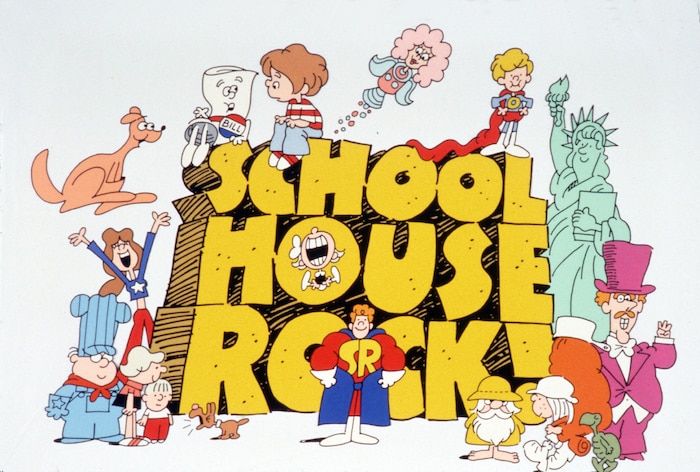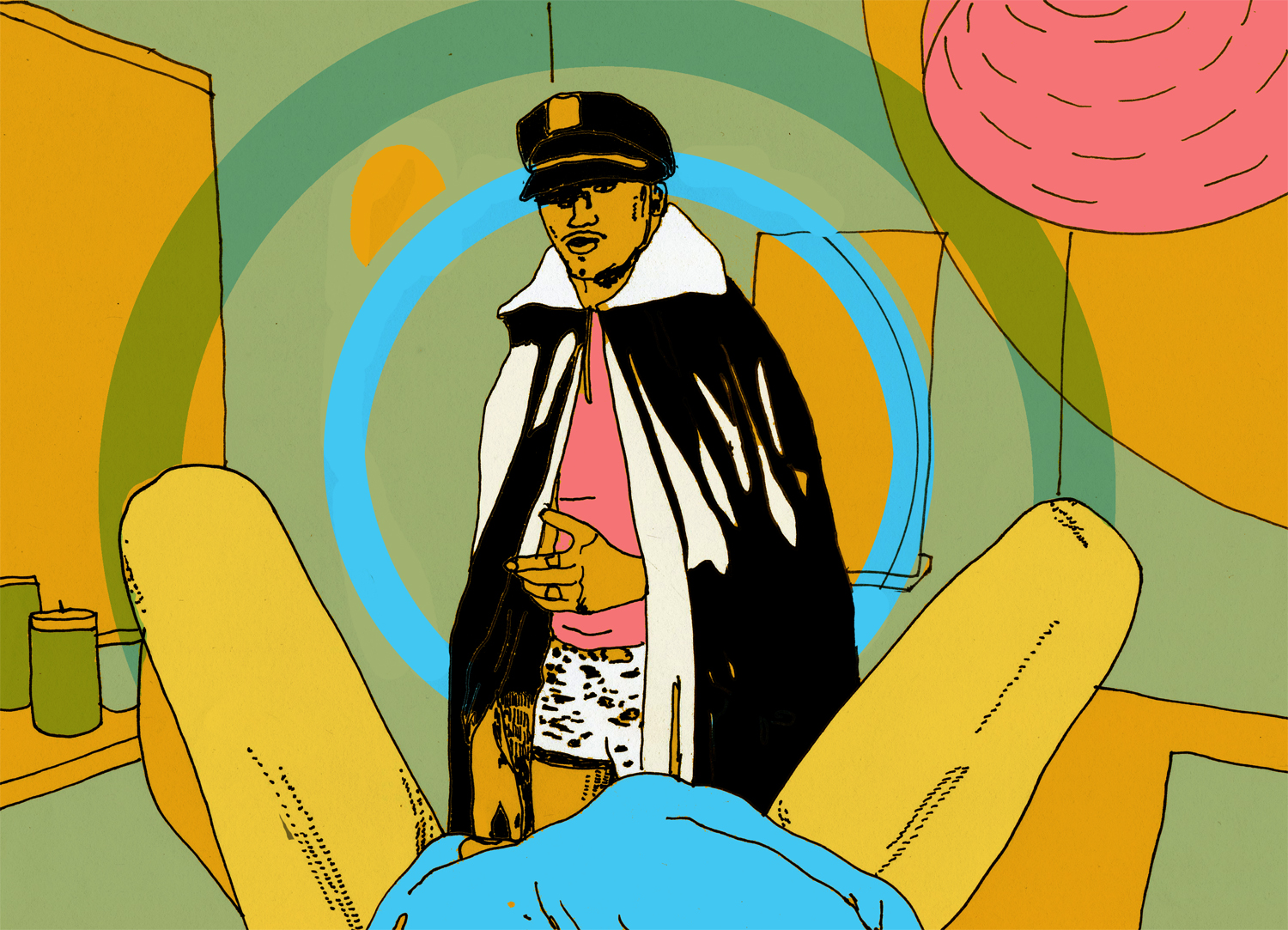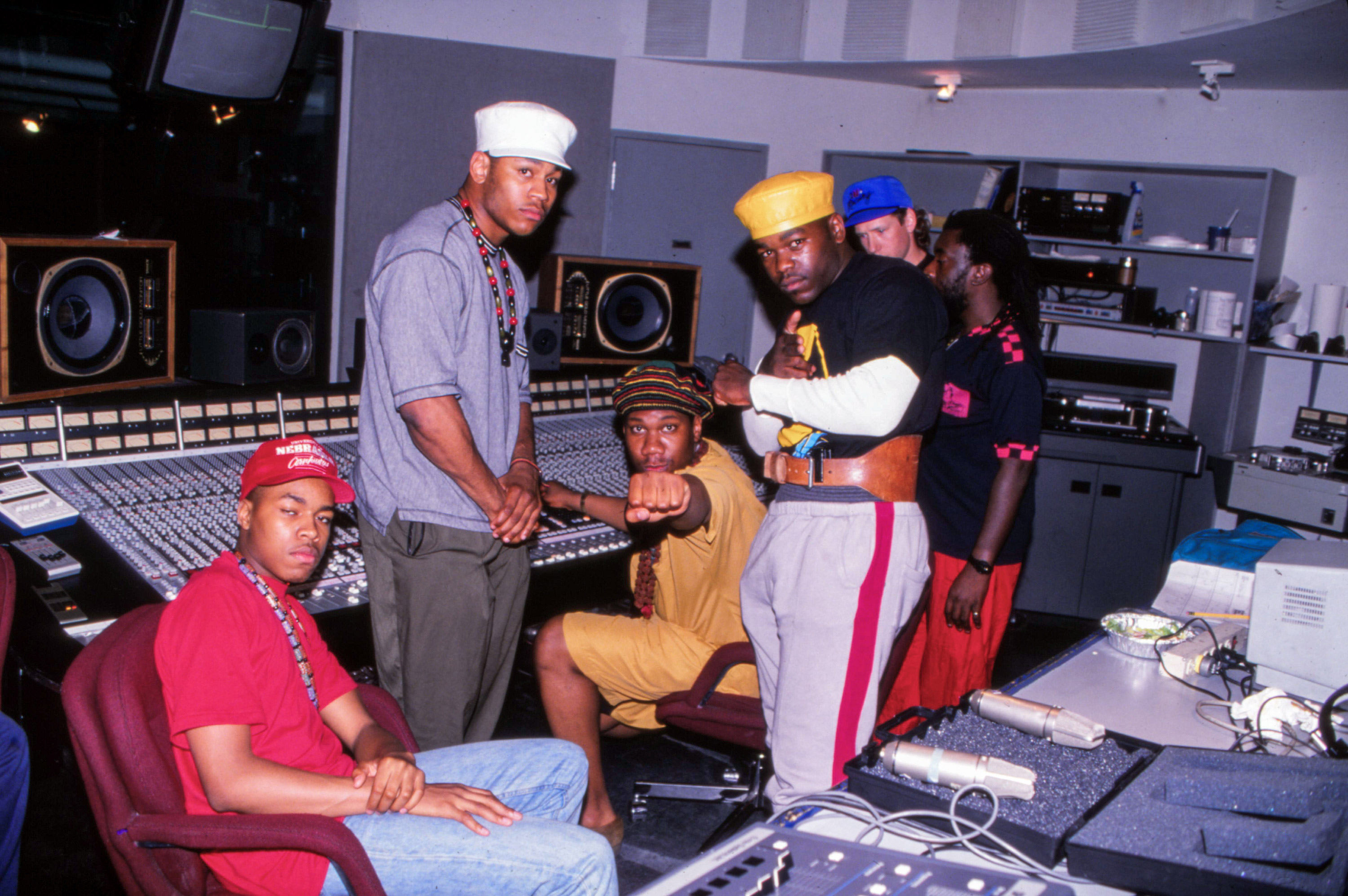The Unlikely Influence of Schoolhouse Rock! on Hip-Hop
How an animated educational children’s TV show from the late 1970s inspired artists from De La Soul to MF Doom and beyond

If you were growing up in America in the late ’70s to mid-’80s, your childhood Saturday mornings might have been spent watching Schoolhouse Rock! The animated TV series ran from 1973 to 1985 and again from 1993 through 1999, totalling 64 episodes that aimed to make mathematics, science, civics, English and history stimulating to kids in three-minute long musical jingles. Schoolhouse Rock! now holds a firm place in American pop culture, continuously parodied, referenced, rehashed and re-recorded in quotable skits from The Simpsons or by talk show hosts aiming to make sense of a Trump presidency. The show made the workings of the world accessible and easily understood each and every weekend, taught a generation how to use a conjunction and, as unlikely as it may be, influenced modern hip-hop.
Although to some hip-hop remains an artform for mature audiences, the genre is stylistically and intrinsically influenced by the childhood infatuations of the MCs and producers who craft the music. The Beastie Boys’ early careers were marketed on adolescent immaturity. Notorious B.I.G’s Juicy is an ode to his youth and leaving it behind, while everyone from MF Doom and Madlib to Aesop Rock project their lyricism through the adopted persona of animated alter-egos.
Both Schoolhouse Rock! and hip-hop in its formative years strived to be a form of social commentary.
“I think the novelty of taking something from people's collective consciousness and flipping it into something new is a PR campaign in itself,” says the Californian beatmaker and rapper Jonwayne on hip-hop’s infatuation with its younger days. “You don’t have to introduce the story or provide some superlative context, the story is right there and can be taken in by anyone who had a relationship with the source material. Like when a caveman cooked an animal for the first time. You see this philosophy extend to the furthest reaches of medium, and the most potent nostalgia emanates from things that affected us as children.”
Schoolhouse Rock! began as a commercial advertising venture by David McCall, co-founder of the Madison Avenue advertising agency McCaffrey & McCall. The idea came in 1971, when McCall noticed his son could remember the lyrics to his favourite rock songs by the Beatles and the Rolling Stones, but never the times tables he was failing to learn in school. Designed both as a bite-size life lesson and a way to fill kids with sugary Fruity Pebbles cereal during its broadcast times between Saturday morning cartoons, McCall enlisted his company’s co-creative director George Newall – a musical composition graduate of Florida State University and musician in his own right – to find the show’s musical curators. American musician Bob Dorough, a jazz pianist and vocalist who performed between sets for the then-controversial American comedian and satirist Lenny Bruce in ‘50s LA, was chosen as the show’s musical director. Dorough’s frequently improvised, witty form of lyricism and songwriting was a perfect fit for the show, and he soon formed a behind-the-scenes supergroup of accomplished names.
Pianist Dave Frishberg and musical theatre songwriter Lynn Ahrens were two of the first to join the Schoolhouse Rock! team, and by the mid-’70s vocalist Essra Mohawk and doo-wop group the Tokens had all written lyrical lessons for the show. Mohawk’s 1970 LP Primordial Lovers was considered to be one of the decade’s greatest avant-garde rock albums (named as one of Rolling Stone’s “25 All-Time Best Albums” in 1977). Mohawk also went on to pen two quintessentially ’80s anthems in Cyndi Lauper’s “Change Of Heart” and Tina Turner’s “Stronger Than The Wind,” while the Tokens’ “The Lion Sleeps Tonight” has become an instantly recognisable classic the world over. Dorough is one of the few vocalists to have ever worked with Miles Davis, spending a day with the jazz great in 1962 to record two tracks; “Blue Xmas (To Whom It May Concern)” and “Nothing Like You.” “Columbia [Records] got the bright idea of making an album for Christmas, and they thought it would be hip if I had this silly singer named Bob Dorough on the album […] the less said about it, the better,” wrote Davis in his 1990 autobiography Davis. “A complete didactic tyrant” is how Dorough would describe Davis 14 years later in an interview with The Oregonian, but he still conceded that Davis was “a great producer,” who “doesn’t waste any strokes.”
What brought these names together under the Schoolhouse Rock! banner was a shared love of blues, jazz, funk and soul: the building blocks of hip-hop. “Schoolhouse Rock! used the power of music and rhyme to teach, which was a founding principal for a lot of early hip-hop,” says Jonwayne, describing Schoolhouse Rock’s enduring appeal. Both Schoolhouse Rock! and hip-hop in its formative years strived to be a form of social commentary – the former’s “I’m Just A Bill,” “The Great American Melting Pot” and “Sufferin’ ’Till Suffrage” all cut topics relating to American law, immigration and the suffragette movement into short bursts of rhyme-a-long song. “There was a certain level of maturity in the playfulness of Schoolhouse Rock!, taking big ideas and effortlessly converting them into song, which I believe is what a lot of lyricists aspire to do,” adds Jonwayne. “It was aimed at children, which forced those who wrote the material to effectively portray their message. They didn’t dumb it down, they just made sure even a kid could understand.”
Bob Dorough’s career began as a songwriter and pianist in late ’40s New York, performing in jazz clubs across the city during what would become known as the “The Bebop Revolution.” Before bebop, jazz had specific stylistic parameters such as a more defined chord structure and stricter time signatures. Bebop, and the hipsters such as Charlie Parker, who formed many of bebop’s foundations, changed that, redefining jazz into what we associate with the genre today (berets, dark sunglasses, goatees and all). Off-beat phrasing, faster tempos, uses of the 9th, 11th and 13th chords and unconventional harmonies became bebop’s defining musical characteristics. The jazz community of the time hated it. “Bebop has set music back 20 years,” said the jazz trombonist Tommy Dorsey of bebop’s jazz blasphemy, but similarly to hip-hop, bebop was a reactionary genre that suffered many of the same criticisms that hip-hop did in its early years by those who misunderstood it. Founded as a rejection of normality and an embrace of growing black pride in the city, bebop was designed to be disruptive, but at the same time it propelled jazz into the upper echelons of modern musical form to become something more intellectually stimulating than its predecessor.
The very first Schoolhouse Rock! song was written by Dorough for the show’s pilot episode in 1973. Called “Three Is a Magic Number,” it was a crash course in the inner workings of the number three and its many uses: “Three is a magic number, yes it is, it’s a magic number,” sings Dorough, a line that helped form one of hip-hop’s greatest crossover hits in De La Soul’s 1989 classic “The Magic Number.” The Prince Paul-produced single, taken from De La’s landmark rap debut 3 Feet High and Rising, helped usher in a new phase of modern hip-hop alongside records from the Beastie Boys (Paul’s Boutique, 1989) and A Tribe Called Quest (The Low End Theory, 1991).
N.W.A, Public Enemy and Geto Boys had set a precedent for hip-hop with a social message years before 3 Feet High and Rising hit the shelves, but it was also the time of gangsta rap. Hip-hop was still a form of confrontational protest, yet the airwaves were filled with records that perpetuated hyper-masculinity and lyrics that boasted more than they did boister. What couldn’t be contested, though, was that hip-hop was advancing rapidly in many different directions at once, thrilling its devoted listeners despite perceived stylistic divergences. 1986’s “The Bridge Wars” pitted KRS-One’s Boogie Down Production outfit out of the Bronx against Marley Marl’s Juice Crew of Queensbridge over hip-hop’s true origins. The rivalry was eventually quashed – the death of a young fan at a Public Enemy/Boogie Down Production show, and the later unconnected murder of BDP member Scott La Rock in 1987, encouraged KRS-One to form the Stop the Violence Movement that lives to this day. Later, well-publicised disputes within the N.W.A camp would begin to pull the band apart in 1989, starting with Ice Cube’s departure. Before that, high profile run-ins with the police had succeeded in enforcing even stronger stereotypes against the hip-hop community and stoking racial tensions, something that would boil over devastatingly in the 1992 LA riots. But in 3 Feet High, hip-hop had found its hippie movement.
“Fly rhymes are stored on a D.A.I.S.Y production / It stands for ‘Da Inner Sound Y’all’ and y’all can bet / That the action’s not a trick, but showing the function,” rhymes Pos on “The Magic Number’s” opening verse, which introduced the world to the D.A.I.S.Y Age – a whimsical form of socially conscious storytelling that found its bravado in the trio’s intellect. “We coined the term ‘The D.A.I.S.Y Age’ after we noticed a nightgown in a store that had a picture of Minnie Mouse holding a daisy on it,” said Pos in a 2014 interview. “Although D.A.I.S.Y stood for “Da Inner Sound Y’All,” it was also about suggesting a sunnier style of rap.”
Signed to Tommy Boy, which by 1989 was part-owned by Warner Brothers, 3 Feet High and Rising found success on both sides of the Atlantic. “In the summer of 1988, De La Soul ushered in the D.A.I.S.Y. age (Da Inner Sound, Y’all)” writes Ta-Nehisi Coates in his 2008 book The Beautiful Struggle. “All our champions were disconnected and dishonored, handing out Image Awards, while we bled in the streets,” describes the journalist and author of the years before hip-hop’s Daisy Age. For many in America’s black communities, the ’80s were a time of “Lionel Richie dancing on the ceiling,” as Coates describes, dominated by “the corporate pop of Whitney,” and where it felt “like Parliament had never happened, like James Brown had never hit.” The D.A.I.S.Y Age helped change that. “But now the word turned Conscious, De La refused to scowl, and Daddy-O shouted across the Atlantic gap,” he writes. “First, Chuck, then KRS, and then everywhere you looked MCs were reaching for Garvey’s tri-color, shouting across the land, that self-destruction was at end, that the logic of white people’s ice had failed us, that the day of awareness was now.”
In the UK “The Magic Number” remains De La Soul’s highest charting single, peaking at #7 on December 23rd, 1989, yet the D.A.I.S.Y Age was bundled into what The Face would brand “The Third Summer of Love.” “Stone Roses on Spike Island, an A-Z of the new bands, Daisy Age fashion, Hendrix and psychedelia,” is how it was immortalised on the magazine’s front pages in July 1990.
“Conjunction junction, what’s your function” may not be as notorious a line as “I said a hip, hop, hippie,” but it still remains prevalent in hip-hop’s lyrical handbook.
“I was once performing a high school summer convention for students, playing mostly Schoolhouse Rock! material,” Bob Dorough, now 93 years old, said on the phone about how his record helped create a hip-hop masterpiece. “When it came time to do ‘Three Is The Magic Number,’ I said ‘Well, here’s a song I wrote for Schoolhouse Rock! and De La Soul plays it,’ and a big cheer went up. So y’know, I gained a little notoriety out of that.”
“When the record came out [in 1989] people kept telling me ‘Hey, De La Soul are stealing your song,’” so I went out and bought the LP, listened to it and thought, ‘Well, it’s close alright,’” continues Dorough, speaking of the time he successfully sued the group. He wasn’t the only one. Produced in a time when sampling remained a legal grey area, acts like De La Soul and the Beastie Boys could cut, paste, and chop samples without much worry. A 1991 lawsuit against De La Soul by the ’60s rock band the Turtles changed that. After sampling the Turtles’ 1968 single “You Showed Me” on “Transmitting Live From Mars,” the Turtles were awarded an out-of-court settlement rumoured to be $1.7 million (although De La Soul dispute the sum was ever that high). The lawsuit ignited a hip-hop paradigm shift from the early ’90s, as sample-heavy albums became an expensive logistical and legal minefield. “I took it to ABC in NYC and said ‘Look here, maybe we can sue these guys or something?’” says Dorough. “But they were out to lunch, if you know what I mean. They just weren’t interested, so I forgot about it for a long time. Later, Disney bought ABC and I talked to a guy about it and he said “I’m going to sue them [De La Soul], I’m going to get them.” Now we get some of the royalties of that song, but after that I sort of became friends with De La Soul. We almost wrote a song together. I wrote a terrific song called “I Am A Human” for Amnesty International which they were going to sing on, but it fell through. Amnesty International lost their funding and closed the door on the whole project. Since then, I haven’t heard from anyone…” Dorough pauses. “But we get some of their money.” And did he like their version of his song? “I did, yeah,” he replies.
Commercially, De La Soul’s “The Magic Number” would be the greatest Schoolhouse Rock! sampling success, but far from the only record it would influence. Taken from MF Doom and Bishop Nehru’s joint 2014 LP NehruvianDOOM, “Om” borrows its psychedelic instrumental from Dorough’s “Little Twelvetoes,” a song originally written in 1973 to teach kids their times tables. On the 1992 LP Stunts, Blunts, & Hip Hop from Diggin’ in the Crates Crew member Diamond D, Dorough’s “The Four-Legged Zoo” is turned into an East Coast staple in “Red Light, Green Light.” The Dorough-penned, Jack Sheldon-recited line “Conjunction junction, what’s your function” may not be as notorious a line as “I said a hip, hop, hippie,” but it still remains prevalent in hip-hop’s lyrical handbook. Songs from Naughty by Nature and Queen Latifah’s “Wickedest Man Alive” and Ol’ Dirty Bastard’s “Give It to Ya Raw” to Redman’s “On Fire” or “What’s Next” and “When We Sippin’ on Tha Brew” from Warren G all borrow the line from Dorough’s “Conjunction Junction.” Big Daddy Kane was described by Rolling Stone in 2012 as “a master wordsmith of rap’s late golden age and a huge influence on a generation of MCs,” and on the 1990 Taste Of Chocolate cut “Who Am I” Kane too makes the conjunction junction his function.
An additional contribution by Schoolhouse Rock! to hip-hop came via American jazz singer Blossom Dearie’s 1973 performance of “Figure Eight,” one of the more unsettling ways of learning the mathematical flexibility of the number eight. Dearie’s child-like tones can also be heard on the show’s “Mother Necessity” and “Unpack Your Adjectives,” but it’s “Figure Eight” that lent itself to more than a few ’90s jams. Compton’s Most Wanted’s “Intro” sampled “Figure Eight” to introduce us to their 1992 LP Music to Driveby, and it likewise popped up in the intro of Diamond D’s Stunts, Blunts & Hip Hop. Havoc and the late Prodigy of Mobb Deep get mathematical with “Figure Eight” on 1999’s “This One (Pyramid Points),” and in the same year Dearie even helped usher in the new Willennium on Will Smith’s “Afro Angel.”
In 1985, the show’s 12 year run came to an end, at least for the first time. Audience numbers had been dwindling for years and ABC were keen to create something that appealed more to the MTV generation, but the show continued to resonate with audiences and musicians alike. Upon its second airing, the album Schoolhouse Rock! Rocks was released in 1996, with artists as varied as Pavement, Biz Markie, Moby and Man or Astro-man? covering some of the show’s most popular hits. Hip-hop has always aimed to encourage the youth vote throughout the decades, with varying degrees of success: Diddy’s Vote Or Die drive, which he led until 2015, was beyond parody from the very beginning, and 2014’s Lil Jon-fronted #TURNOUTFORWHAT campaign never truly resonated beyond an ill-thought out YouTube video. But while 1998’s Schoolhouse Rocks the Vote!: A Benefit for Rock the Vote may not have turned the political landscape on its head, Etta James (“Sufferin’ ’Till Suffrage”), Sugarhill Gang (“Fireworks”), Joan Osborne & Isaac Hayes (“I’m Just A Bill”) and the Roots with Jazzyfatnastees (“Three-Ring Government”) all came together to cover Schoolhouse Rock! classics and introduce them to another generation.
Bob Dorough remains humble, surprisingly unaware of his sizeable legacy within the hip-hop world. “They were young rock & rollers I guess, making hip-hop or something... I heard they were ahead of their time in terms of sampling, and hip-hop...singing? Nice group...” he says, attempting to describe what De La Soul helped create. But although Dorough may not recognise his own credentials, the cross-generational influence of his music isn’t lost on him. “It really feels great,” he says, his voice lifting an octave. “I now meet lots of kids who grew up watching the cartoons on a Saturday morning. Even now they really think I’m the cat’s meow.”

